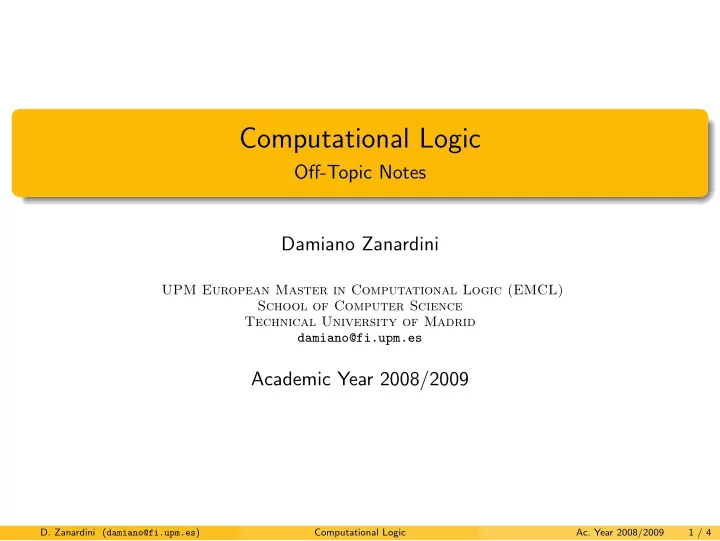

Computational Logic Off-Topic Notes Damiano Zanardini UPM European Master in Computational Logic (EMCL) School of Computer Science Technical University of Madrid damiano@fi.upm.es Academic Year 2008/2009 D. Zanardini ( damiano@fi.upm.es ) Computational Logic Ac. Year 2008/2009 1 / 4
Constants, Names, Equality and Domainsp Is Madonna a dancer? When we say b refers to Madonna we mean: that b is a constant, i.e., a name that Madonna is not a name, but a real person! So that it does not make sense to ask dancer (Madonna)?: rather, we should ask dancer ( b )? according to the usual meaning of equality, a = b if both a and b refer to the same person: Madonna Jim Henle is Madonna means that they are the same person, which amounts to say a = b On the other hand, the meaning of using 1 as a constant is that the constant 1 (i.e., the name 1) refers to the natural number 1 4 � = 5 because the name 4 denotes (refers to) the number 4, while the name 5 denotes the number 5 The second situation is equal to having a constant Madonna which denotes the person Madonna D. Zanardini ( damiano@fi.upm.es ) Computational Logic Ac. Year 2008/2009 2 / 4
Completeness and G¨ odel’s first incompleteness theoremp Completeness vs. incompleteness the completeness theorem says that every logically valid formula is provable G¨ odel’s first incompleteness theorem says that if an effective theory is consistent and expressive enough to describe arithmetic , then there is a formula F which is true but not provable in the theory both theorems can hold for the same theory � � ☎ mmh... what are we missing here? ( ¬ completeness) � = incompleteness the completeness theorem talks about fomulæ which are logical consequences of a theory the G¨ odel’s first incompleteness theorem talks about a theory which cannot prove some F (which is not a logical consequence of the theory) D. Zanardini ( damiano@fi.upm.es ) Computational Logic Ac. Year 2008/2009 3 / 4
Completeness and G¨ odel’s first incompleteness theoremp Peano’s Arithmetic (first-order version) ∀ n ( nat ( n ) → n = n ) 1 ∀ n ∀ m (( nat ( n ) ∧ nat ( m ) ∧ n = m ) → m = n ) 2 ∀ n ∀ n ′ ∀ n ′′ (( nat ( n ) ∧ nat ( n ′ ) ∧ nat ( n ′′ ) ∧ n = n ′ ∧ n ′ = n ′′ ) → n = n ′′ ) 3 ∀ a ∀ b (( nat ( a ) ∧ a = b ) → nat ( b ))) 4 nat (0) 5 ∀ n ( nat ( n ) → nat ( s ( n ))) 6 ∀ n ( nat ( n ) → ¬ ( s ( n ) = 0)) 7 ∀ n ∀ m (( nat ( n ) ∧ nat ( m ) ∧ s ( n ) = s ( m )) → n = m ) 8 ∀ ¯ y (( φ (0 , ¯ y ) ∧ ∀ n ( φ ( n , ¯ y ) → φ ( s ( n ) , ¯ y ))) → ∀ m ( φ ( m , ¯ y ))) 9 every logical consequence of this theory is provable (see also Deduction theorem) there is a formula which is true but cannot be proven in the theory D. Zanardini ( damiano@fi.upm.es ) Computational Logic Ac. Year 2008/2009 3 / 4
Wrong deductions: Euclid’s Fifth Postulatep A (2000+)-year-old problem (from 300 b.C. to XIX Century) Given a straight line segment can be drawn joining any two points 1 any straight line segment can be extended indefinitely in a straight line 2 given any straight line segment, a circle can be drawn having the segment as 3 radius and one endpoint as center all right angles are congruent 4 is it possible to prove if two lines are drawn which intersect a third in such a way that the sum of 5 the inner angles on one side is less than two right angles, then the two lines inevitably must intersect each other on that side if extended far enough ? D. Zanardini ( damiano@fi.upm.es ) Computational Logic Ac. Year 2008/2009 4 / 4
Wrong deductions: Euclid’s Fifth Postulatep Non-Euclidean geometries the mathematicians Karl Friedrich Gauss , J´ anos Bolyai and Nikolai Ivanovich Lobachevsky ( Lobaq´ evski˘ i ) independently came to the conclusion that no proof exists there exist models of the first four postulates where the fifth postulate does not hold spherical geometry hyperbolic geometry is the fifth postulate true in the real world? in other words, is our geometry euclidean or curved ? logicians basically don’t care, but philosophers do! Einstein’s theory of general relativity seems to give an answer... D. Zanardini ( damiano@fi.upm.es ) Computational Logic Ac. Year 2008/2009 4 / 4
Recommend
More recommend